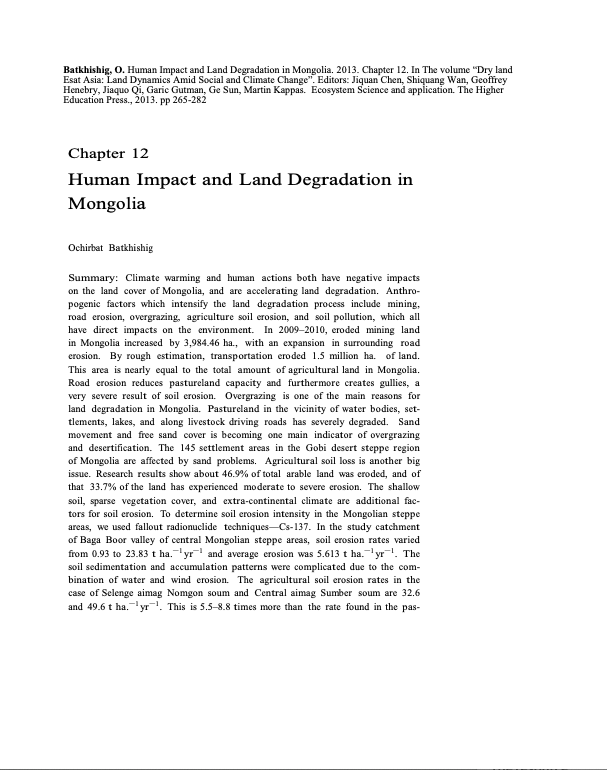Resource information
Climate warming and human actions both have negative impacts on the land cover of Mongolia, and are accelerating land degradation. Anthropogenic factors which intensify the land degradation process include mining, road erosion, overgrazing, agriculture soil erosion, and soil pollution, which all have direct impacts on the environment. In 2009–2010, eroded mining land in Mongolia increased by 3,984.46 ha., with an expansion in surrounding road erosion. By rough estimation, transportation eroded 1.5 million ha. of land. This area is nearly equal to the total amount of agricultural land in Mongolia. Road erosion reduces pastureland capacity and furthermore creates gullies, a very severe result of soil erosion. Overgrazing is one of the main reasons for land degradation in Mongolia. Pastureland in the vicinity of water bodies, settlements, lakes, and along livestock driving roads has severely degraded. Sand movement and free sand cover is becoming one main indicator of overgrazing and desertification. The 145 settlement areas in the Gobi desert steppe region of Mongolia are affected by sand problems. Agricultural soil loss is another big issue. Research results show about 46.9% of total arable land was eroded, and of that 33.7% of the land has experienced moderate to severe erosion. The shallow soil, sparse vegetation cover, and extra-continental climate are additional factors for soil erosion. To determine soil erosion intensity in the Mongolian steppe areas, we used fallout radionuclide techniques—Cs-137. In the study catchment of Baga Boor valley of central Mongolian steppe areas, soil erosion rates varied from 0.93 to 23.83 t ha.− 1 yr− 1 and average erosion was 5.613 t ha.− 1 yr− 1. The soil sedimentation and accumulation patterns were complicated due to the com- bination of water and wind erosion. The agricultural soil erosion rates in the case of Selenge aimag Nomgon soum and Central aimag Sumber soum are 32.6 and 49.6 t ha.− 1 yr− 1. This is 5.5–8.8 times more than the rate found in the pasture area. The soil erosion in agricultural fields of Mongolia is thus significant. Land conservation policy and adequate land management practice is therefore currently very important in Mongolia.

